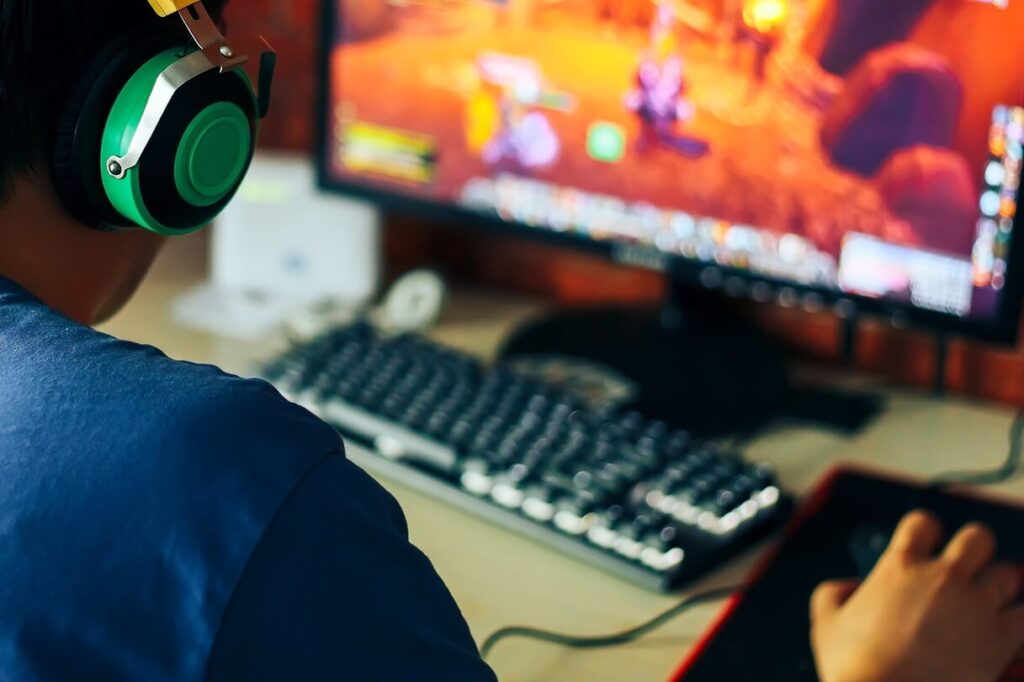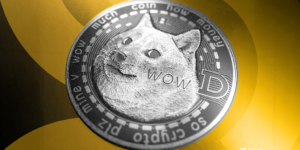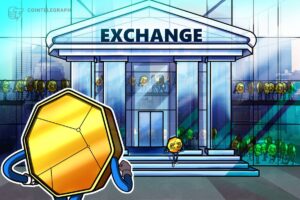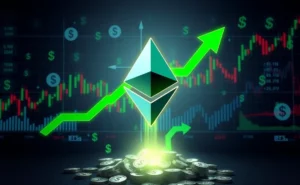Play-to-Earn, Gamification, Interoperability and Major Publishers

_____
_____
Along with NFTs, games are the blockchain industry’s leading segment in terms of usage.”Another factor to consider is the overall trend toward gamification, which will see other blockchain categories reimagined.”Major game developers are beginning to see the potential of blockchain and crypto for gaming.
Video games have long been regarded as a Trojan horse for new technologies. Whether it be home computers, smartphones, or virtual reality, the pleasure of gaming is usually one of the most effective ways of interesting the public in new tech, and the same is true when it comes to blockchain and cryptoassets.
In fact, Cryptonews.com prophesied that video games will drive blockchain adoption way back in 2018, and this prediction really does seem to be coming true, with 2021 seeing greater interest in blockchain-based games. And according to a range of industry figures, such games will attract even more usage and adoption this year, with play-to-earn (P2E) and GameFi (decentralized applications (dapps) with economic incentives) most likely being the dominant trends.
On top of this, many analysts expect major game developers and publishers to enter blockchain-based gaming to some degree this year, with the use of NFTs proving a big draw. However, while 2022 might witness considerable growth for crypto-gaming, there might still be a considerable degree of experimentation as the sector decides what works and what doesn’t.
Play-to-earn driving continued blockchain-gaming growth
Make no mistake: games are big for the crypto sector, as explained to Cryptonews.com by DappRadar’s co-founder and Chief Development Officer (CDO), Dragos Dunica.
“Along with NFTs, which currently lead in terms of trading volumes, games are the blockchain industry’s leading segment in terms of usage. Similarly to Q4, over 50% of unique active wallets interacted with gaming dapps [decentralized applications] [last] month, meaning that, despite the crypto crash, this category remained stable,” he said.
Dunica explains that one particular area of the crypto-gaming sector is key for its growth: play-to-earn. As its name suggests, this is a model where players receive rewards (usually NFTs or native tokens) for playing a given title, with Axie Infinity being the most notable example.
“Play-to-earn has been a key driver for gaming’s increasing popularity, and it’ll likely remain so. That the top five games — Alien Worlds, Splinterlands, Farmers World, Axie Infinity, and Upland — are, all in all, retaining their users is a good indicator of this trend continuing over the next few months,” he added.
Other commenters agree that play-to-earn will likely retain its crown as blockchain-gaming’s biggest trend for 2022. This includes Nigel Carlos, the spokesperson for Zug-based Dacoco, the publisher of Alien Worlds.
“Play-to-earn games will definitely be dominant in 2022. These games give users purpose and meaning through economic incentives, which not only draw people to play-to-earn games — granting real world utility — but also allow users to collaborate and compete, strategize, and create strong relationships with one another,” he told Cryptonews.com.
However, analysts working outside of the crypto sector tend to urge caution in evaluating just how big blockchain-gaming is and will become in the near-future. One of these is Michael Pachter, Managing Director of equity research at Wedbush Securities, who suggests that blockchain-based games aren’t yet big enough to really qualify as a fully fledged category.
“[This is] mostly because only one (Axie Infinity) has figured out how to exploit the power of the blockchain and how to make a game fun. Axie Infinity has a few million [daily active users, DAU], but there are 3.5bn people who play games and probably close to 400m DAU playing all games on PC,” he told Cryptonews.com.
Interoperability, hybridization, and gamification
2022 also might see expanding interconnections between blockchain-based games and other parts of the crypto sector, with each sector using others to help them grow.
“Interoperability and the use of NFTs in blockchain games are trends that we are seeing in many games, Alien Worlds included,” said Nigel Carlos. “NFTs have proven to have immense potential in conferring utility to users, and will continue to be extremely useful in blockchain games.”
Carlos also adds that interoperability will become an important growth strategy for many games, as they strive to attract communities — and liquidity — from other chains.
Continuing with the theme of a growing overlap between gaming and other areas of crypto, Dragos Dunica suggests that more platforms will seek to gamify themselves in various ways.
“Another factor to consider is the overall trend toward gamification, which will see other blockchain categories reimagined. DeFi platforms are a case in point — they’re already pivoting toward GameFi offers, which will bring in new users more easily than complex, pure DeFi dapps,” he said.
An early example of this is DeFi Land, a gamified DeFi platform that runs on Solana (SOL) and raised USD 4.1m in seed capital in September. It launched its public beta at the end of December, and could be part of a big trend of financialized games/gamified finance platforms.
Big developers and publishers
Another trend we might see in 2022 will be the growing involvement of major publishers with blockchain and NFT elements in their games.
“Major game developers are beginning to see the potential of blockchain and crypto for gaming, especially after having witnessed the popularity of blockchain adoption across multiple industries,” said Nigel Carlos.
According to him, while many remain weary, claiming there is still a long road ahead of us, we will begin to see some bigger names dip their toes in the blockchain space in the very near future.
Turning to NFTs and cryptoassets will potentially open up the products of publishers such as EA and Activision (recently acquired by Microsoft) to a new customer base, while it will also allow them to offer their current users new and exciting products. This potential has already been noticed by the market, with Dragos Dunica noting that blockchain gaming is already becoming a big business.
“Last year saw [venture capitalists] pour USD 4bn into the space, meaning that traditional gaming is unlikely to miss out on the action,” he said.
However, Dunica suggests that it may be difficult for established developers to enter the burgeoning space of crypto-gaming, and for various reasons.
“The likes of Electronic Arts and Ubisoft, who publicly support blockchain projects, have faced backlash from traditional gamers […] There continues to be mistrust in blockchain projects from the mainstream,” he said, adding that many crypto-native gamers may be naturally wary of traditional publishers and their more centralized models.
Still, Dunica says that, sooner or later, traditional publishers and developers will have to enter the space to some degree, even if we don’t see much of this in 2022.
“Although I can’t project how much traditional gaming developers’ revenues will increase or decrease as they enter blockchain gaming, new revenue streams will gradually replace old ones. What I can say for sure is that individual gamers’ revenues will increase as gaming shifts towards a blockchain-based and player-centered model,” he said.
Similarly, Michael Pachter says that, while initial involvement may remain cautious for a while yet, most major houses will get involved.
“I expect all publishers to experiment in 2022, with low levels of investment until another business model is proven out. All seem to appreciate that in-game items can be tokenized and already have value, but are slow to appreciate that the real value is in allowing players to trade NFTs,” he said.
Elaborating on this point, Pachter explains that the current model is based too much on the sale of digital items that can’t be sold on afterwards by the players who first purchase them.
“The publishers want to sell the gamers the car, weapon, football player, and are worried that if they allow gamers to re-sell the items purchased, the existence of a secondary market will limit sales by the publisher,” he explained.
That said, Pachter also notes that, by creating extra value of a given NFT, resales risk re-classifying certain games as gambling, insofar as gamers who are lucky enough (to sell an NFT for more money than they paid for it) may be considered as having ‘won’ a bet.
“This is a serious problem for many games with in-game purchases, and I expect all publishers to move very slowly before adopting tradeable NFTs,” he said.
Continuing momentum?
Given that the wider crypto market is experiencing something of a downturn (as of writing), you’d be forgiven for wondering whether blockchain-based games such as Axie Infinity, the Sandbox and Alien Worlds can keep up their momentum.
Well, while the jury is still out on whether specific games on their own can maintain their runaway popularity, analysts agree that blockchain-based gaming is only going to grow in the medium-to-long term.
“It’s far more likely that interest will grow with each new game, so the calculus is whether the number of new games will grow faster than the growth of players. That’s likely, and it is likely that the early movers like Axie Infinity will grow more slowly as the market evolves,” said Michael Pachter.
Equally, Nigel Carlos explains that the play-to-earn model at the heart of many crypto-based games incentivizes gamers to continue playing.
“These games offer the opportunity to experience success, mastery, and dominance, and as users improve their gaming skills, they increase their confidence and competence. We have seen first-hand the network effects from users enjoying, not only the benefits of economic incentives that give users real-world utility, but also the community aspect of progressing and learning strategies together,” he said.
This all suggests that, notwithstanding the ups and downs of the market, blockchain-based gaming has a bright future ahead of it. Even if 2022 confronts it with a bear market. ____Learn more:- Layer 2 in 2022: Get Ready for Rollups, Bridges, New Apps, Life With Ethereum 2.0, and Layer 3 – What’s in Store for DAOs in 2022?
– Crypto Tax Trends in 2022: Increased Reporting, Updated Rules, and a Wealth Tax Debate- Metaverse Trends in 2022: Prepare for More Gaming and New Virtual Experiences with NFTs
– Bitcoin & Crypto Mining in 2022: New Locations, Technologies, and Bigger Players- CBDCs in 2022: New Trials and Competition with Crypto
– NFTs in 2022: From Word of the Year to Mainstream Adoption & New Use Cases- Bitcoin and Ethereum Price Predictions for 2022
– Crypto Adoption in 2022: What to Expect? – 2022 Crypto Regulation Trends: Focus on DeFi, Stablecoins, NFTs, and More
– DeFi Trends in 2022: Growing Interest, Regulation & New Roles for DAOs, DEXes, NFTs, and Gaming- Crypto Security in 2022: Prepare for More DeFi Hacks, Exchange Outages, and Noob Mistakes
– How Global Economy Might Affect Bitcoin, Ethereum, and Crypto in 2022- Crypto Exchanges in 2022: More Services, More Compliance, and Competition- Crypto Investment Trends in 2022: Brace for More Institutions and Meme Manias
Find more predictions for 2022 here.















